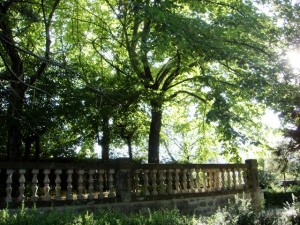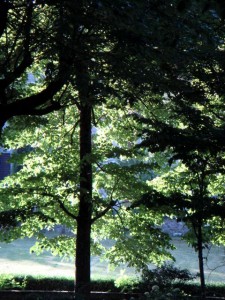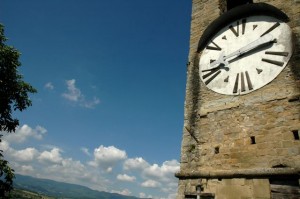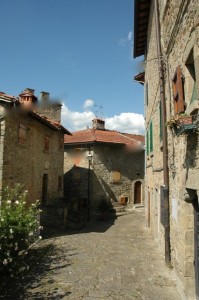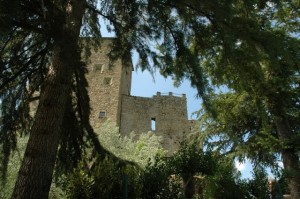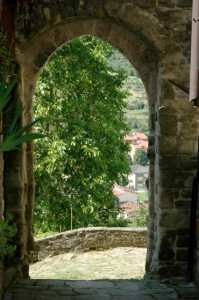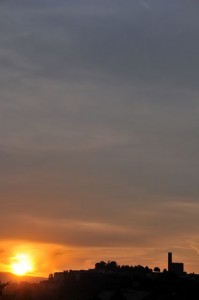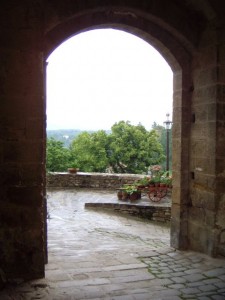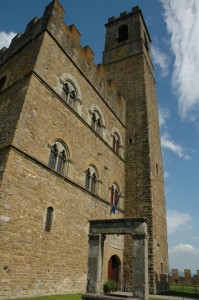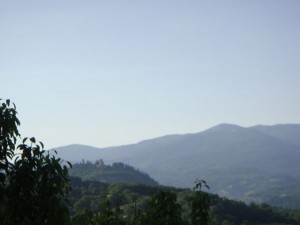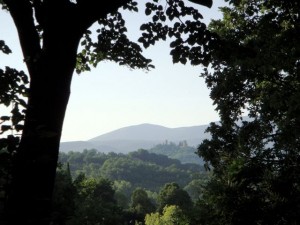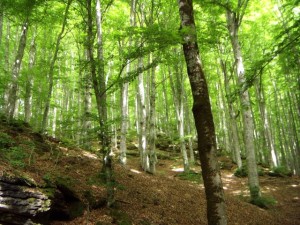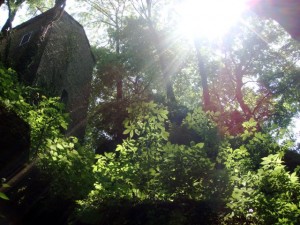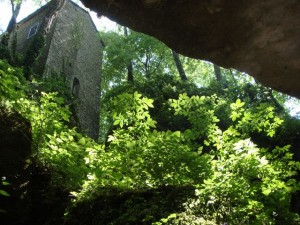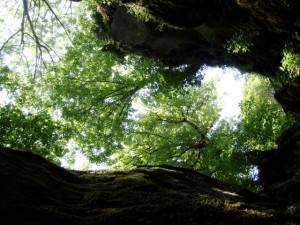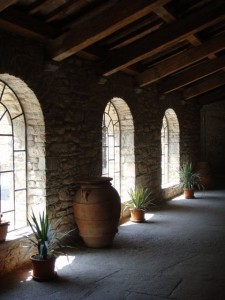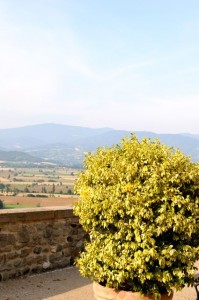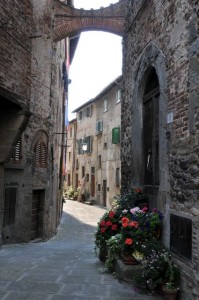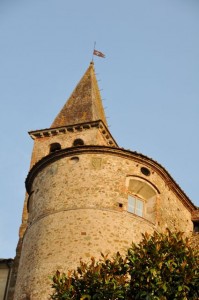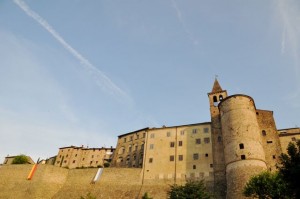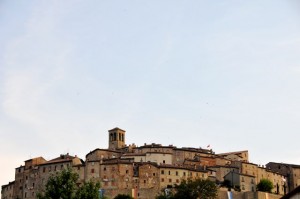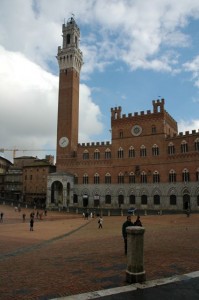DAY EXCURSION SUGGESTIONS
Note from Peter:
Sharon and Gerry from Victoria, Canada, stayed with us for three weeks in 2006. They thoroughly explored the area and left these very useful notes for future guests. We think that you will find them valuable.
The following is a list of day trips from La Massa that we particularly enjoyed during our stay here in May/June 2006. We understand that it will be extremely difficult to tear yourself away from the peaceful ambience of La Massa but here are some suggestions for touring that can easily be done in the mornings so you will be back to enjoy the pool by noon or earlier if you wish. But then there is the distinct possibility that you will likely find a perfect place for an enjoyable lunch or discover yet another detour to explore. We have included some suggestions for full day trips as well.
I. THE CASENTINO VALLEY
You are situated in a part of Tuscany that truly deserves to be explored. The Casentino valley is considered one of the most beautiful valleys of Tuscany and here you will find endless opportunities for discovery.
(a) Strada in Casentino/Castel San Niccolo
The Strada in Casentino is the closest market town from here. It has a good alimentari, a nice bakery (which has lots of groceryitems as well) and some other shops. We found this medieval village an interesting place to roam around. Park you car in the square and take a walk along the river, make sure you cross over the bridge and explore the alleyways on theother side. Up the hill from the bridge you will find the 11th century Castel San Niccolo with its interesting Watch Tower.
Saloon Le Lele serves good pizza (you can take out as well) and the owner is very friendly.
From the Strada and area there are innumerable backroads to explore. For example the road to Cetica will take you through wonderful medieval villages and beautiful scenery. Another good outing is to take the road to Consuma via Caiano. Stop at the Bar Consuma for a schiacciata with tomatoes and mozzarella, add a beer or a glass of wine and sit on the outdoor terrace. There is a wealth of places to explore and detours to take, we found it all very enjoyable. Ask Peter or Danny about walks in the area as well.
(b) Poppi and area
A must in Poppi is the Il Castello dei conti Guidi which dominates the landscape in this area. Between 1000 and 1440 the Casentino was ruled by the Counts Guidi family who had their headquarters in Poppi. Their castle here is said to be the best preserved medieval castle in the region and it is well worth visiting. We toured the castle on a Sunday morning and it was very quiet in Poppi, thus we were able to drive right into the historic center and park on the street nearby the castle. Included in the price of admission to the castle is an audio tape and headphones (available in many languages) which made our tour all the more interesting. Before you leave, walk around the ramparts outside the castle for the stunning views. When you leave the castle you will be in the Piazza Republica. If you are ready for lunch, the Casentino Albergo-Ristorante has been recommended. We opted to have coffee at the lovely outdoor bar in the Piazza where you can just sit and watch all the Italian families enjoying their Sunday morning. Don’t leave the historic centre until you have had a chance to walk around and explore the old streets and the churches.
When you descend on the road from Poppi, instead of returning to Ponte Poppi, take the road in the direction to Quota (marked on the maps). Enroute you will pass the Casentino Golf Club with its outstanding views and its Ristorante il Palazzo. If you stop for lunch/dinner here sit outside on the lovely covered terrace and enjoy the wonderful view with your meal. Leaving here you will continue to climb and wind the roads to Quota. We were very happy to come across this very quaint medieval village. You cannot drive your car in here but there is plenty of parking just outside the village. Exploring this tiny ancient village was one of the highlights of our trip.
We had a lovely lunch one day at the La Torricella Ristorante (clearly signposted in Ponte a Poppi). This is a popular place as it has a very nice outside terrace (and a lovely dining room inside) with views of Poppi castle. The menu is in both English and Italian and the food is very good. You can easily spend a couple of hours here enjoying the quiet ambience.
(c) Bibbiena and area
Highly recommended is a visit to the historic centre of Bibbiena (yes there is more to Bibbiena than just trips to the Co-op). There are many places to park up here and it is just a short, not too steep, walk from the parking lots into the historic centre.
Peter recommended this visit and we are very glad he did. Make sure you have a coffee and a pastry at the Bar Le Logge Del Tarlati in Piazza Tarlati. Sitting outside under the loggia in the wonderful padded chairs was a delight ( we did this more than once). There has been a great deal of work done revitalizing the historical centre and from Piazza Tarlati there are two streets well worth exploring for the many beautiful shops. If you come across the ready made pasta shop, pick up a lasagna and enjoy at home tonight.
Just before you enter Bibbiena make a right turn on the road signposted for Raggiolo. Raggiolo is a beautiful, unique, small medieval hill town. We went up there as Peter had recommended the Il Convivio dei Corsi restaurant in Raggiolo. We did not get to eat at the restaurant as we were too early for lunch, but we were so happy that we made the trip here regardless. Take your time and wander the lanes and alleyways, we think you will find it to be a wonderful experience. And, of course, if time permits have a meal at the restaurant as it looked very nice and it appeared to have a good menu. Ask Peter for further details on the
restaurant.
(d) Stia and area
Stia is a pretty, medieval town centered around the large porticoed Piazza Tanucci. Don’t be hesitant to drive into the historic centre as there is generally lots of parking in the Piazza Tanucci. There is a very nice patisserie in the Piazza with outside
tables and chairs, a great place to have a coffee and watch the activity. Directly across from the patisserie is the Santa Maria Assunta Church which contains several valuable works of art. In the Piazza you will also find a small Co-op store, an excellent bakery, lots of nice shops and the recommended Filetto Ristorante.
In the old days, Stia was the market town for the Guidi counts whose nearby Castello di Porciana guarded the narrow Arno Valley. Near the Castle (4 kms N of Stia) is the Sanctuary of Santa Maria dell Grazie, a small but interesting 14th century church. The Church is not always open but when we were there one of the women who lives in the building attached to the Church (it may be a convent) was kind enough to open the doors for us.
Pratovecchio is a few kms south of Stia and from here you can access the Castel di Romano and the beautiful Pieve de Romena. The day we visited we took a road which runs off the SR 70 between Consuma and Borgo alla Collina. This route was wonderful as you winded through a beautiful peaceful valley. The Pieve de Romena has been called the most beautiful Romanesque church of the Casentino valley and we would have to agree. We were not able to get inside the church (check the brochures for opening times) but we took a lot of pictures and wandered around the back gardens of the Church. Nearby you will find another Guidi
Castle, the Castello di Romena which is said to have been one of the most powerful in the Casentino with its 3 sets of walls and 14 towers (only 3 towers now exist). The Castle is now privately owned so access is restricted, but it is worth the drive up just to see it.
(e) Sanctuary at La Verna
A visit to the Sanctuary at La Verna, north-east of Bibbiena, was truly one of the highlights of our trip. This famous Franciscan monastery sits high up on a rocky outcrop in the middle of the beautiful Casentino forest. It was here in 1224 that St. Francis of Assisi became the first person to ever receive the stigmata. The churches, chapels and convent at La Verna are simple and rustic, but the main church, the chapel of Stigmata and St. Francis’s tiny church of Santa Maria degli Angeli are decorated in beautiful Andrea della Robbia terracottas. The views all around are amazing.
Peter has a great book on La Verna on the table at La Massa which explains the entire history and the layout of La Verna, it is well worth reading. The drive upwards and downwards is beautiful so take plenty of time to stop and take some walks. Bring a jacket with you as it is always cooler up in the forest and you might like to take a picnic lunch with you. If a picnicis not in order, then lunch at La Toricella Ristorante (noted above) would make a perfect day. (Peter says here that at La Verna, they do great lunches to include wine at a very reasonable rate – eat where the Franciscans eat!)
(f) Eremo di Camaldoli and the Archicenobo di Camaldoli
Another highlight is north-east of Poppi on a beautiful road through the National Forest Park of Casentino which leads up to the ancient hermitage founded in the 9th century by St. Romualdo, a Benedictine monk who longed to found a community of hermits similar to those of the early Christians. The Eremo di Camaldoli has 20 cottages set in the pines, where the hermits exist in silence and solitude. You cannot enter this area of solitude, but you can tour the rest of the Eremo and the cell where St. Romualdo lived is open for viewing.
300 Metres down from the Eremo is the Archicenobo di Camaldoli (the monastery) also founded by St. Romualdo. As the story goes, a conflict arose during Romualdo’s time as the piety of the hermits attracted pilgrims and visitors who interfered with their solitary meditations. The monastery, which was founded lower down from the Eremo, had a more relaxed rule and was created for the purpose of entertaining visitors and caring for the forest domain that belonged to the Benedictine order.
The ancient pharmacy at the monastery is well worth investigating. In the pharmacy the monks sell their balsams, herbal remedies and liqueurs. Take a peek in the museum attached to the pharmacy, lots of interesting ancient things in here. Just around the corner from the pharmacy you will find the entrance to the monastery, make sure you go in and have a look
around.
(g) The Vallambrosa (shady valley)
The Vallambrosa can be easily accessed from La Massa via Montemignaio and is famous for its abbey founded by San Giovanni Gualberto of Florence and it is still the headquarters of his Vallombrosan order. Just a short ways from here is the village of Saltino, a small summer resort surrounded by enormous fir trees, which the guide books says is an excellent base for a walk. The guide books also note that one of the most beautiful routes leads up to Monte Secchieta (4,753 ft) affording views over most of north-central Italy.
We did not actually spend any time up here but passed through the area on our route home from a long day trip to Chianti (further details below). It is very beautiful and we always intended to return there and explore but we ran out of time.
II. FULL DAY TRIPS TO OTHER AREAS
(a) Arezzo
We would highly recommend you take the train to Arezzo. It is very easy and comfortable and you will not have to worry about driving and parking in Arezzo. The trip from the Porenna station (where you park for free and purchase your ticket at the bar right beside the station) to Arezzo takes just under one hour and it is a very pleasant and scenic journey. From the train station in Arezzo, it is an easy walk up the Via Guido Monaco to the old centre where it ends in Piazza San Francesco. Stop and have a coffee at the outside bar in the Piazza and get your bearings. In this Piazza is the San Francesco Church which houses three of Piero della Francesca’s frescoes. From here you can climb up the signposted street to the Piazza Grande, the centre of the historic area, where you will see Santa Maria della Pieve (with its round Romanesque apse) and several other historic buildings. From here you will climb again following the signposts to the Doumo. The cathedral was built in bits and pieces over the centuries and contains several great works of art. The Capella della Madonna del Conforto here was very special.
There is an impressive range of stores (most not open on Monday) in both the historic centre and the lower areas of Arezzo. There are also many restaurant choices. We can recommend lunch at Caffe La Torre on Corso Italia (right near the Piazza San Francesco) which is a quiet, interesting place with inside and outside dining.
A note about the return train to Porenna: When we arrived in Arezzo we were able to obtain a train schedule for our return trip at the magazine kiosk in the train station. This is also where you purchase your train tickets. Don’t bother lining up at the main cashiers because they do not seem to sell tickets for this routing although there are automated machines close by but we were not able to figure them out.
(b) Santa Sophia
This was another day trip recommended to us by Peter and again we were happy we did it. Santa Sophia is a pretty and interesting town, but the real pleasure to us was the drive there and back which was incredibly scenic and provided you with great views of two very different landscapes.
Starting in Stia it was a wonderfully scenic drive through the Casentino National Park, takingthe S 310 via Passo La Calla, Campigna, Corniolo, Berletta and Cabelli. On our return we traveled via the Passo dei Mandrioli, San Piero in Bagno, Bagno di
Romagno (lots of activity going on there), Bradia Prataglia, Soci and Bibbiena. This route took us through some very rocky landscape but it was equally scenic and beautiful as well.
(c) The Valtiberina Valley (upper valley of the Tiber)
This day trip will take you through the patchwork of pasturelands and woodlands that make up much of the Valtiberina valley. This valley is well known as the birthplace of Piero della Francesca and Michelangelo. This trip will take you to Anghiari, Monterchi, Sansepolcro and Caprese Michelangelo.
Taking the main highway, SR 71 from Ponte a Poppi, you will be traveling south to Capolona. From the main highway, you will see the signposts for Anghiari and Sansepolcro. Anghiari was definitely one of our favourite medieval hill towns. It has steep narrow streets, charming little squares and a wonderful atmosphere. Make sure you spend some time here as we think you will be surprised and charmed. Make sure you take a picture from the vantage point on the road which passes around Anghiari as you can see the whole panorama of the town from the backside.
Monterchi is 8 kms from Anghiari. Monterchi is a tiny medieval town most famous for Piero della Francesca’s extraordinary fresco the “Madonna del Parto”.
Sansepolcro is approximately 15 kms from Anghiari. It is the largest town in the Valtiberina Valley and is famous for lace, pasta and as the birthplace of Pierro della Francesca. You cannot drive into the old city, but there is lots of parking by the gates into the city. The day we visited (a Tuesday) there was a very large street market going on, which added to our enjoyment. At the Museo Civico you can see Francesca’s masterpiece “The Resurrection” and several other of his works.
Caprese Michelangelo is 26 kms east of Sansepolcro and was the birthplace of Michelangelo. According to the guidebooks Michelangelo only returned once to the Valtiberina area and that was to select sturdy firs to float down the Tiber which were used as scaffolding in the Sistene Chapel. Nonetheless, Caprese Michelangelo is a very small, pleasant place and the Casa del Podesta houses a museum here in his honour. There is also a nice Bed and Breakfast in the village with a beautiful outdoor balcony for dining but the day we were there it was very busy with a tour group who stopped here for lunch. It looked like
a good restaurant and likely would be worth checking out if you are in the area.
Returning home, we opted not to go all the way back to the SR 71, and instead took a route which takes you via Chiusi della Verna and back to Bibbiena. If you choose this route, look over your right shoulder as you are descending the road. You will get an excellent view of the Sanctuary of La Verna sitting high up on its craggy outcropping.
(d) The Chianti Region
This is a fairly long day trip but very worthwhile. We only covered a tiny portion of the Chianti region but we had determined from our reading that in this beautiful countryside nothing is essential viewing, everywhere is a glorious detour. With that
philosophy in mind, we found some true gems which were recommended in some guidebooks.
En route to the Chianti we drove from Rassina (south of Bibbiena) via Talla, La Crocina, San Guisti Valdarno, Montevarchi, and then a pleasant but quick stop in Cavriglia. From here we headed towards Radda in Chianti but that was not our destination.
Volpaia, a 13th century borgo, is said to be the most picturesque village in the Chianti. Following the road to Radda, make a right turn when you see the signpost for Volpaia. Volpaia is 7kms north of Radda and a very windy road climbs from the main road
up to this enchanting medieval village with its ancient castle and walls, its beautiful church “La Commenda”, an enoteca and some interesting places to eat. All of this encircles Volpaia’s doll-sized Piazza della Torre– we were instantly charmed. Take some time to wander this enchanting place. There is no entry for cars but the parking lot is close by. The Castello di Volpaia is apparently a first-rate wine estate (also fantastic olive oil) and their enoteca in the centre of the village is open for direct sales.
La Bottega is a small alimentari with a few tables inside and outside for sandwiches/snacks. If you want a full Tuscan meal you can enjoy the upstairs dining room or dine on the terrace in the back garden with stunning views. We did not have lunch here but the menu looked good and was reasonably priced. La Bottega is owned and operated by the Barucci family and they also have a bar/light meal place with an outdoor terrace just across the Piazza della Torre calle Bar-Ucci.
Lamole was our next destination. We thought we would have to return from Volpaia to the main highway and access Lamole from the main road between Panzano and Greve. To our delight, just before entering Volpaia we had seen a sign to Panzano so we decided to follow this road which leads you through a small street in Volpaia, past the wine estate and before long we ended up in Lamole. Lamole is a tiny hilltop village with a small parish church, a few houses and a castle that is a hotel. We wanted to come here and experience the Ristoro di Lamole that we had seen so highly recommended on many websites. This is an extremely popular restaurant with a lovely terrace and of course, beautiful views. There was no more seating for lunch this day so we simply tasted some of the excellent Lamole di Lamole wines at the wine shop attached to the restaurant and, of course, made some purchases. Filippo and Paulo, the owners of the restaurant, were extremely pleasant people, spoke English very well
and the restaurant menu is in English as well. We met some fellow Canadians a little later in the day who were staying at a villa in Lamole and who had dined several times at this restaurant and they also gave it excellent reviews.
Ristoro di Lamole (closed Wednesdays) – Tel: 055-854-7050 (reservations strongly recommended) www.ristordilamole.it
Greve in Chianti was our next destination. Descending the road from Lamole to Greve, we passed by Vignamaggio (a beautiful old villa which is now a wine estate) which was built by the Gherardini family. Their daughter Lisa was born here, better known as the Lisa who posed for Da Vinci’s “Mona Lisa” Greve in Chianti is the capital of Chianti and the centre of the wine trade. It is a nice place to rest and there are several restaurants and many shops in the lovely Piazza di Greve. This lovely stone village with its streets cobbled in a circular pattern is a great place to wander around and it has an excellent gelateria as well.
Returning home, we decided to try an alternative route to the one we took to the Chianti. This route took us from Greve via Dadda, Ponte agli Stolli, Figline Valdarna, Insica in Val D’Orno, then the road to Regello, Saltine, Vallambrosa, down the mountain through Montemignaio and then home This route was a total of 65 km and it took us 1 hour 45 minutes.
Our route going to Greve was a total of 113 kms and it took us 3 hours but that includedseveral stops. Both routes are scenic and interesting, although the roads were less windy and twisty going.
An excellent day !!
(e) Siena and area
It takes about 2 hours to drive from here to Siena but again we were very pleased that we made the trip. Many of the guidebooks call Siena a medieval city “par excellence” and they are spot on. You do not take your car inside the historic city, you leave your car in one of the outlying car parks and take the shuttle bus to the old centre. We followed the road signs for Porta Ovile and parked our car at the lot near there. From there we took an escalator up several levels to the old city and came out at the San Francesco church and from there it was about a 10 minute walk to Il Campo.
The Piazza del Campo is stunning. When you first see it as you descend the stairs from the street above through narrow arcades, you can understand why the guide books say there is no lovelier square in Tuscany. Surrounding the square are many bars and restaurants, all with outdoor tables and covered with shady canopies. We so enjoyed having a coffee here (don’t be surprised by the price) and taking in the beauty of the Piazza. There are vendors and many stores selling souvenirs here as well as lots of tour groups but they do not detract from the main attraction, the Palazzo Pubblico (the brick and stone town hall), whose upper floors have been made into the city’s museum. After you have experienced this, you return to the main street above which is very well signposted to all the other historical sights. However, like us, I think you might get sidetracked by all the beautiful shops with an amazing variety of clothing, wines, pastas, shoes, etc which line this main street. But you won’t want to miss
the Doumo, Siena’s glorious cathedral in the Piazza del Doumo. The interior of the cathedral is a virtual treasure box of magnificent works of art. There is so much to take in, it is hard to decide where to look. But do look down as there is 12,000 square metres of beautiful marble flooring inlaid with many beautiful depictions. We overheard one of the many tour guides in the Doumo mention to her tour group that row 11 of the Cathedral provides you with a good viewing point for many of the treasures. We followed that advice and sat there for the longest time taking in the surroundings. We can’t begin to remember everything we saw but a good guidebook will take you through it. Before you leave the Doumo, stop in for a look at their gift shop as they have excellent postcards, etc.
There are many other historical sites in Siena which we did not see as we had some other explorations to do before returning home. Leaving Siena enroute to Arezzo you travel through the Valdichiana valley which is the largest and broadest valley in the Appenines. According to the guidebooks, on both sides of this valley are the most beautiful villages in this part of Tuscany. Today we are focused on the west side of the valley and in particular the villages of Monte San Savino (21 kms from Arezzo) and Lucignano (south of Monte San Savino). Lucignano was our first stop and we loved this cheerful little village. Apparently it
is quite unique among Italian hill towns for its street plan as it is laid out in 4 concentric ellipses, like a kind of maze with 4 picturesque little piazza in the centre. We met a couple who vacation here every year as they consider Lucignano so special. We did not have enough time to do much other than walk some of the streets, but it would be well worth doing a more thorough exploration of this lovely little place. We decided to bypass stopping in Monte San Savino but we did read that it was well worth a visit as well.
Overall a long, but a most enjoyable day!!
(f) Cortona and area
Cortona was our final day trip, but what a wonderful day it was in spite of the drive. (Peter can provide you with the train schedule for Cortona and if you only plan on visiting Cortona and spending most of the day there, we think taking the train would be a very good idea. Apparently the train station for Cortona is at a small village about 5 kms outside of Cortona – I cannot remember the name – from there buses will take you to Cortona).
Cortona is on the east side of the Valdichiana valley about 35 kms south of Arezzo. Cortona has long been considered to be among the “crown jewels” of Tuscan hill towns andmade all the more popular in recent years by the book and film “Under the Tuscan Sun”. As you approach Cortona, there it sits in all its splendour on terraced slopes of olive trees and grape vines and amongst some stunning villas.
Cortona, like Siena, is quite touristy, but its beauty quickly overshadows this feeling. The heart of Cortona is the Piazza della Repubblica, a striking square with cobblestone lanes leading off in all directions to picturesque streets, wonderful churches and other sites to explore. The Piazza and the main street leading to it is full of shops and a large choice of patisseries and restaurants to enjoy. We lingered in Cortona for quite a while but we were also anxious to visit Montepulciano, which is about 30 kms south of Cortona. Montepulciano is another beautiful hill town, best known for its wine. The Porta al Prato is the main gate into the city but again you cannot drive in but there is lots of pay parking just outside the gate. Unfortunately, we were quite tired when we arrived here so we did not explore very much of Montepulciano but from what we did see I think it would well be worth spending several hours here.
Wanting to get back to La Massa as quickly as possible, we took the A1 Autostrada from Montepulciano (in the Florence direction), exiting at Valdarna and then the road via Talla and Rassina and home.
To all the future guests at La Massa we wish you a wonderful stay at this beautiful place in this beautiful part of Tuscany. We know you will be taking many beautiful memories home with you.
Gerry and Sharon Ferguson
June 10, 2006
